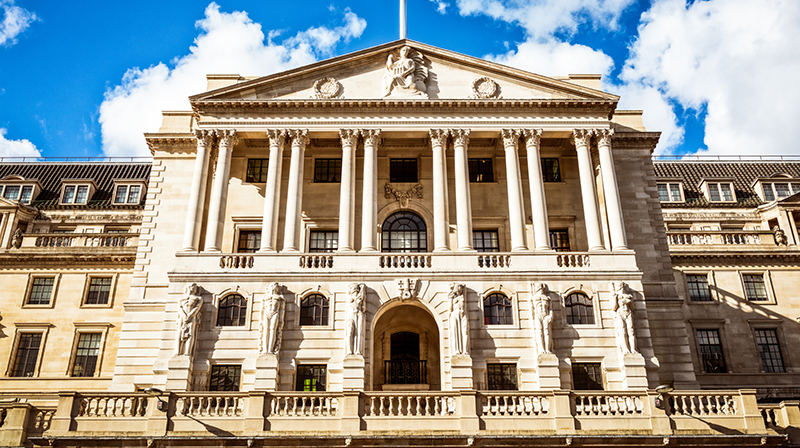The Bank of England’s decision to hold interest rates at 5.25% has come as no surprise to wealth managers and DFMs, according to industry commentators, although some have remarked that the hawkish tone set by the Monetary Policy Committee as well as the split vote has “put the cat squarely among the pigeons”.
On 14 December, six out of nine members of the MPC voted to keep interest rates at their current levels for the third time in a row, meaning they will remain at a 15-year high for another month. The remaining three members wanted to hike rates by a further 25 basis points to 5.5%, in a bid to tackle stubborn inflation.
Andrew Bailey, governor of the Bank of England, said that while the UK has “come a long way this year”, with inflation falling by more than five percentage points since the start of the year, there remains “some way to go” to achieve the 2% inflation target.
The decision comes a day after the US Federal Reserve also decided to keep interest rates on hold, although Fed chair Jerome Powell’s commentary suggested rate cuts might be on the cards in 2024.
Hetal Mehta, head of economic research at St. James’s Place, said the Bank of England’s hawkish tone “sets it markedly apart from the Fed”.
“Underlying inflation is still uncomfortably high and the recent pricing of multiple rate cuts from early next year was clearly an easing of financial conditions that the BoE felt the need to push back against,” he explained. “The fall in wage inflation so far is not enough to be consistent with the 2% inflation target.”
Indeed, Hugh Gimber, global market strategist at JP Morgan Asset Management, concurred that with wage growth still above 7% and inflation higher than 4%, “it’s too early for the Bank to declare victory in its battle against inflation”.
“Markets have been increasingly keen to bring forward the timing of UK rate cuts over recent weeks, but this appears to have been driven much more by changes in expectations for the Fed and the European Central Bank rather than anything in the domestic data that would justify such a move,” he said. “We do expect the Bank to lower interest rates in 2024, but only once there are clearer signs of the labour market loosening”.
Seema Shah, chief global strategist at Principal Asset Management, believes the BoE is likely to be “one of the last central banks to cut rates next year, despite having more pressing economic slowdown concerns”.
She said: “The Bank of England’s decision not to raise rates today will not have shocked anyone, but its hawkish tone has likely come as a bit of surprise, coming hot on the heels of yesterday’s dovish pivot from the Fed.
“The UK is struggling with a more elevated and persistent inflation problem so, while recession risk is more pertinent for the UK, the Bank of England needs to maintain its restrictive stance for a prolonged period to ensure inflationary pressures subside sufficiently.”
Indeed, the fact that three members of the MPC voted to hike rates further has “put the cat squarely among the pigeons”, according to AJ Bell’s head of investment analysis Laith Khalaf.
“It’s a salutary lesson that the Bank’s primary focus is inflation, and that you shouldn’t try and second guess the voting intentions of nine people in a room,” he said. “For now, the mixed outlook from the Bank’s interest rate committee will probably act as a brake on the fall in short-term interest rates we’ve seen in the last couple of months, and put upward pressure on mortgage market pricing.
He pointed out that it has only been two years since the Bank of England first started raising rates from lows of 0.1%. “When you look back at how far we’ve come it’s hard not to feel a dizzying sense of vertigo,” Khalaf continued.
“Markets are now thinking what goes up must come down, and are pricing in a slew of interest rate cuts next year. That looks premature and probably reflective of the current sentiment in markets, driven especially by the US Fed’s latest more dovish stance on interest rate policy.
“Going forward wage growth is a key metric to watch in the UK. This has been falling back, but the hawkish members of the committee believe current levels are incompatible with meeting the 2% inflation target, and increases to the National Living Wage may serve to embed higher wage demands.”
Stephen Payne, portfolio manager at Janus Henderson, argued that while the UK’s decline in inflation is “lagging behind that in the US”, the “direction of travel” still looks clear.
“The market reaction has been muted, with a modest uptick in gilt yields, still to levels below yesterday’s close, given the Fed news overnight,” he explained. “Sterling has strengthened against the US dollar, given interest rates look set to stay higher for longer in the UK.
“The Fed inspired rally in the UK equity market has also moderated marginally, although the market is still strongly up on the day.
“It is clear that markets are paying more attention to the Fed and assuming that the Bank of England will in time follow suit on a more dovish path.”







